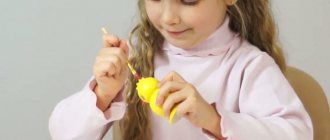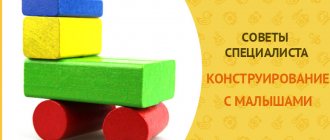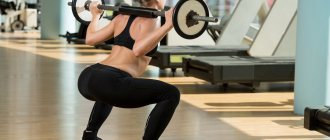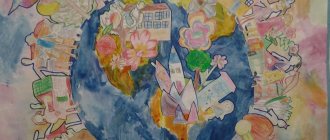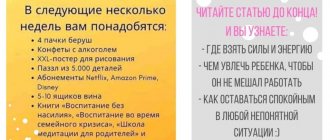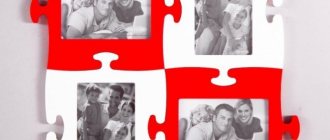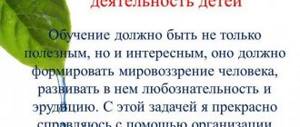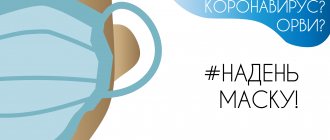Experimental lesson in kindergarten
Experimental classes in kindergarten are structured taking into account the age characteristics of children in a time frame according to SANPiN standards:
- junior group - 15 minutes;
- middle group - 20 minutes;
- senior group - 25 minutes;
- preparatory group - 30 minutes.
To prevent overwork, various forms of activity are used: gaming (didactic games), physical (physical education, outdoor games), entertaining (singing), cognitive (studying visual material, conducting a conversation).
Practical work is preceded by a repetition of safety rules and a recitation of the sequence of actions during the experiment. At the end of the experiment, each student tidies up his/her workplace and helps the teacher put away the tools.
A reflection stage is required at the end of the lesson: the guys report the results of the experiment and share their emotions from the discovery process.
Card index of experiences and experiments - table
| Experimentation area | Lesson topic | Purpose of experimentation | Materials |
| Objects of inanimate nature | "Properties" | Introduction to the properties of sand | Jars of dry sand, water bottle, spatulas, plexiglass, magnet |
| "Water purification" | Introduce the method of filtering water | Glass with dirty water, empty glass, cotton filters for water purification | |
| "Fabrics" | Formation of ideas about the properties of various types of fabric | Containers with water, scissors, fabric samples | |
| "Metals" | Formation of ideas about the properties of metals | Alcohol lamp, matches, scissors, metal samples (demonstration experiment, conducted by a teacher) | |
| "Magnetic property of the Earth" | Introduction to the magnetic properties of the Earth | Magnet, glass, needles, model of the globe, magnetized safety pin, water, vegetable oil | |
| "Rainbow" | Introduce the mechanism of light decay into a color spectrum | Cut glass (part from a crystal chandelier) | |
| “How do I get a paperclip?” | Expanding ideas about the properties of a magnet and its use by humans | Container with water, paper clips, magnet | |
| "Polar Lights" | Expanding the understanding of the Earth's magnetic forces | Magnet, metal filings, two sheets of paper, cocktail straw, balloon, small pieces of paper | |
| "Space in a glass" | Finding out the factors influencing the shape of the planets | Glass with water, oil, alcohol, pipette | |
| Wildlife objects | "Roots Extend" | Establishing a connection between the modification of plant parts and the influence of external factors | Plants in pots with trays simulating various external factors |
| "Property of evaporating liquid" | Establishing the dependence of the amount of evaporated liquid on the size of plant leaves | Three indoor plants: with small leaves (Ficus retusa), with medium leaves (Ficus Benjamin), cactus | |
| "Light and Growth" | Establishing the relationship between lighting and plant growth | Houseplants, sheet of paper, pencils | |
| "Thrifty Plants" | Getting to know the ability of some plants to accumulate moisture | Container with water, food coloring, wooden blocks, sponges | |
| "Like a flower drinks water" | Forming an idea of the movement of water from the root of a plant along the stem to the leaves and flower | Glasses of water, food coloring, white carnations | |
| "Heat and Cold" | Establishing the influence of temperature on plant growth | Branches with unopened buds, cups of water | |
| "Plants breathe" | Establishing the plant's need for air | Houseplants, plastic tubes, Vaseline, magnifying glass | |
| "Living Piece" | Establishing the ability of a plant to feed and grow from the root | Root vegetables (carrots, radishes, radishes, turnips, beets) | |
| Human body | "Ear and nasopharynx" | Establishing a connection between the ear and the nasopharynx | Model of the structure of the ear and nasopharynx |
| "Smell and Breathe" | Establishing the need for inhalation to detect odor | A thick fabric bag with various aromatic materials: soap, orange peel, scented candle, perfume bottle. | |
| "Perception of cold and heat" | Determine the location of points on the human body that perceive heat and cold | Containers with hot and cold water, knitting needle | |
| "Eyes" | Introduction to the structure of the eye | Human eye model | |
| "Pupil" | Study the effect of light on the pupil | Mirror | |
| "Snore" | Learn about the causes of snoring in humans | Wax paper, scissors, ruler |
Children will learn experimentally how to remove metal objects from a container of water without getting their hands wet.
Summary of experimental activities in the second group of early age “Water, water...” - table
| Goals |
|
| Equipment | Toy “Luntik”, a transparent glass of water, scoops from a sand set, rags. A glass of cold water, a container with hot water (the teacher takes it out only during the experiment, without access for children). |
| Progress of the lesson | The children and the teacher go to the reception area. At this moment, a loud sound is heard in the group. When the teachers and children return to the group, they see a puddle of water on the table and “Luntik” next to it. Educator: Guys, what happened in the group? Who came to visit us? Do you know him? Children: Luntik! Educator: Hello, Luntik. Guys, let's say hello to Luntik. Children: Hello, Luntik. Educator: Guys, it seems that Luntik is upset about something. He said that he was in such a hurry to meet you, he didn’t notice a glass of water on the table and accidentally knocked it over. What happened to the water that was in the glass? Children: Spilled. Educator: We need to remove the water from the table. Shall we help Luntik? Children: Yes. Educator: Luntik just whispered to me that the water needs to be collected in a glass in the same way as we collect toys. Do you think it is possible to put water in a glass? We put the toys back into place with our hands, so we’ll collect the water too! Come out (Calls several kids), help us collect water. Children run errands. Educator: Did you manage to collect water in a glass? Children: No! Educator: Or maybe we can collect water with scoops. Let's collect sand! Calls a few more children to carry out the assignment. Educator: Guys, the water doesn’t return to the glass. How else can you collect water from the table? Children: With rags. Educator: Let's try. Children who have not yet participated in the experiment come out. Educator: Look, Luntik, the guys and I wiped everything off. Rags helped us with this. Do you know why we couldn’t collect the water with our hands and a scoop? Because water is liquid. When we spill something liquid, it turns out to be a puddle. And rags help to collect a puddle. What other liquids do you know? Children's answers. Educator: There is also liquid milk, tea, cocoa, soup. What does our nanny do when something suddenly spills? Children: Wipes with a cloth. Bottom line. Educator: Luntik thanks you guys for your help and says that now he definitely remembers that he will help him collect the liquid if he suddenly spills it. Luntik says goodbye to the kids. |
Children establish a way to clean up spilled water from the table surface
Recording the results of experimental activities of preschool students
Recording the results of practical research or observation is a mandatory stage of experimental activity. Children need to be taught to fixate gradually, since this type of work is considered difficult for preschoolers. And this stage is necessary in order for the results of the experimentation to be imprinted in the pupils’ memory (visual, sensory, auditory, motor, olfactory).
Ways to record the results of children's experimentation:
- Graphic. The simplest way to record results visually using ready-made forms: cards, pictures, graphic diagrams, photographs, three-dimensional images, audio recordings. This method can be used in experimentation with children 3–4 years old, asking them to choose from several ready-made forms the one that represents the results of practical work in the current lesson. With pupils of the middle group, simple graphic diagrams or mnemonic cards are used.
- Mental. To record the results of experimental activities, children's speech skills are used: the child talks about the results of practical research. The mental method is used in working with children of the middle group: pupils develop the ability to independently pronounce the results of the experiment, compare them with the results of similar experiments conducted earlier. During mental fixation, older preschoolers improve their ability to generalize and systematize knowledge about objects.
- Practical. It consists of recording the results of experimentation on paper - by sketching or writing. When working with preschoolers, schematic sketching and sketching with conventional symbols are more often used. For this purpose, children keep observation diaries, experiment logs, and fill out experiment cards. The teacher writes down a story about the results of practical research in kindergarten from the words of the children, for example, to secure a report on the work done in the group journal, on a stand in the knowledge corner.
Students sketch the results of the experiment on observation sheets.
Consultation for parents
It is recommended to hold meetings with parents several times during the school year, which highlight the work of children in the framework of experimental activities. Parents are informed of the goals and objectives of children's experimentation; they must understand its significance for the development of the child's personality. Cognitive activity and the desire to conduct practical research must be encouraged at home.
Support for experimental activities of children is carried out through the implementation of the following tasks:
- encouraging the child’s curiosity and initiative in experimentation;
- showing interest in kindergarten activities;
- motivate by personal example.
At consultations for parents, the teacher provides sample topics for joint experimental activities with children at home and on walks (for proactive parents - topics for short-term research projects): seasonal observations on the street, a description of performing experiments in the bathroom, in the kitchen. The importance of recording the results of practical research should be pointed out: parents together with their children can keep diaries and journals, draw posters, make collages from photographs and laptops (folding books on the topic of the experiments carried out - “Three forms of water”, “Conditions of plant growth”, “ Methods of soil purification", "Properties of air"). Experimenting with your family (with mom and dad, brothers and sisters, grandparents) is not only the acquisition of knowledge, but also positive emotions.
Conducting experiments at home creates a positive atmosphere in the family and is remembered for a long time
Monitoring and reporting on experimental activities in preschool educational institutions
To evaluate the results and effectiveness of students’ experimental activities, the teacher conducts monitoring according to the following criteria:
- the ability of students to pose problems;
- correct formulation of questions;
- choice of research methods;
- the ability to describe observations during experimental activities;
- presence of thinking skills (analysis, comparison, generalization, systematization);
- degree of independence in conducting the experiment;
- ability to make inferences, conclusions, summing up;
- ability to record the results of experimentation.
A high level of experimental activity is evidenced by a stable motivation to conduct practical research, including in independent activities (on walks, in independent activity centers, at home). A child with a developed research type of thinking takes the initiative in choosing materials and tools for conducting experiments, identifies problematic issues, tests his own assumptions experimentally, and strives to complete what he started in order to find out and record the result of the experiment.
To identify the attitude of pupils towards experimental activities and determine the level of mastery of practical skills, the teacher conducts monitoring by filling out questionnaires for each pupil several times during the school year (in September, in the middle of the year, in May). Monitoring reveals the degree of independence at all stages of children's experimentation; for students with low scores, the teacher selects correction techniques.
Design of the experimentation center
An important condition for organizing experimental activities in kindergarten is the creation of a subject-cognitive environment. These could be corners for practical research in the group room, green areas on window sills for observing plants. It is possible to prepare a separate room for the functioning of a circle for cognitive and research activities. There should be a designated area in the research corner or laboratory for displaying student projects or for thematic exhibitions. To store educational literature, materials for experiments and instruments, shelving is provided, access to which will be open to all children. For carrying out experiments, a place is thought out: a demonstration table, student desks and chairs. Safety rules when conducting experiments should be clearly presented (for example, in the form of a poster).
Particular attention is currently being paid to creating water and sand centers in the group. By experimenting with these substances, children not only gain knowledge, but also improve fine motor skills, and also restore the balance of their emotional state (exercises with water and sand calm them down, eliminate symptoms of fatigue, and relieve muscle tension).
Material equipment of the experimentation center:
- natural materials: sand, stones, clay, soil, wood samples, leaves, grains;
- instruments: magnets (including magnetic shavings), magnifying lenses, rulers, telescope, scales, microscope, thermometer, lamps;
- vessels: glasses, bowls, jars, beakers, flasks;
- medical materials: latex gloves, tweezers, disposable syringes without needles, cotton pads, gauze and bow;
- substances: salt, sugar, potassium permanganate, food coloring, flour;
- aprons, goggles, hats or scarves, gloves, sleeves;
- observation sheets and journals for recording the results of experimentation.
Examples of design for a practical research corner - photo gallery
A specialized corner provides wide scope for experimental activities
Accessibility and safety are the main criteria for organizing a research corner
The research corner should be attractive and encourage independent searches for information.
In the mini-laboratory, all materials are stored in labeled boxes
In the educational center you can and should touch everything
Thematic collections of experiments should be stored in the experimentation corner
The experimentation center may contain objects of living and inanimate nature
Examples of design of the center of water and sand - photo gallery
The center is easy to organize with your own hands
An example of colorful design class=”aligncenter” width=”556″ height=”417″[/img] In addition to sand and water, other natural materials for experimentation (pebbles, shells) can be presented in the corner
Children conduct experimental games in the center of sand and water
Sand and water activities help you relax and unwind
Activities with sand and water evoke positive emotions in students
Children's experimentation as a teaching method
CONSULTATION FOR TEACHERS
"Children's experimentation as a teaching method"
Before giving knowledge, it is necessary
teach to think, perceive, observe.
V. Sukhomlinsky
Experimentation can be used in various types of organized and independent activities of preschoolers. They like classes where, together with adults, they make their first discoveries, learn to explain and prove. Children are happy to talk about their discoveries. They carry out experiments, learn to put forward new problems and solve them independently.
Adults should create conditions for experimentation. The group must have a mini-laboratory equipped with everything necessary.
In the course of experimental-cognitive activity, situations are created that the child resolves through experimentation and, by analyzing, draws a conclusion, independently mastering the idea of a particular physical law or phenomenon.
Experimental work arouses the child's interest in exploring nature, develops mental operations, stimulates cognitive activity and curiosity, activates the perception of educational material on familiarization with natural phenomena, the basics of mathematical knowledge, the ethical rules of life in society, etc.
Experiments are accompanied by children pronouncing and putting forward many hypotheses and guesses, attempts to predict the expected results. This has a positive effect on speech development and the ability to construct complex sentences. Draw conclusions. Repeated repetition of the same experiments, characteristic of many children, develops in them a certain algorithm of actions, precision in performing certain operations, and accuracy in work.
A preschool child by nature is characterized by an orientation towards understanding the world around him and experimenting with objects and phenomena of reality. An experiment independently conducted by a child allows him to create a model of a natural science phenomenon and summarize the results obtained in an effective way and compare them. Classify and draw conclusions about the value significance of physical phenomena for a person and himself.
The value of a real experiment, in contrast to a mental experiment, lies in the fact that aspects of an object or phenomenon of reality hidden from direct observation are clearly revealed; the child’s ability to identify a problem and independently choose ways to solve it develops; a subjectively new product is created.
Experimentation stimulates a child's intellectual activity and curiosity.
The development of children's ability to experiment is a specific system, which includes demonstration experiments carried out by the teacher in specially organized activities, observations, and laboratory work performed by children independently in the spatial-subject environment of the group.
In everyday life, children often experiment with various substances themselves, trying to learn something new. They take toys apart, watch objects falling into the water, test metal objects with their tongues in severe frost, etc. but the danger of such “amateur activities” lies in the fact that the preschooler is not yet familiar with the laws of mixing substances and basic safety rules. An experiment, specially organized by a teacher, is safe for the child and at the same time introduces him to the various properties of surrounding objects, the laws of life of nature and the need to take them into account in his own life.
In a preschool educational institution, the acquisition of knowledge about physical phenomena and methods of knowing them is based on the child’s keen interest and curiosity and is carried out in a fun way without memorizing, memorizing and repeating rules and laws in a formalized form. An experiment in kindergarten allows children to be introduced to specific research methods, various methods of measurement, and safety rules when conducting an experiment. Children, first with the help of adults and then independently, go beyond the knowledge and skills acquired in specially organized activities and create a new product - a building, a fairy tale, air saturated with smells, etc.
Elementary experimentation is already available to children of early and early preschool age. They are happy to examine sand, clay, dough, paper, plaster, wood, fabric, paints, learning their beneficial and harmful properties; splashing in the water, revealing its secrets; they send boats sailing, catch the breeze, launch airplanes; they try to make foam and paint with it; turn snow into water, and water into colorful pieces of ice; blowing soap bubbles. Children learn to actively apply their acquired knowledge in games. Playing with sand and water not only brings children joy and emotional balance, but also develops a whole range of skills and abilities, developing motor skills and hand coordination, tactile senses, imagination, thinking, fantasy, and speech.
In middle age, experiences become more complicated. Children are already able to find answers to difficult questions: how do grains turn into flour? How to knead the dough? How to catch air? Why are there so many puddles in autumn? Why does the plant drink? And so on.
The range of phenomena that older preschoolers experiment with is expanding. Children determine the properties of a magnet. They learn what sound is, how sound waves travel, how to make a sound louder and how to record it, and turn sunlight into “colored lights.” They discover with interest the laws of motion, inertia and space.
Living nature is also an object of study: what does a worm smell, how old is a fish, what fungi are always hungry, how flowers bloom...
Experiments allow us to learn a lot about a person: “Let's check the hearing”, “Flexible bone”, “Skin color”, “Why does a person snore?” and etc.
The experience of search and experimental activities acquired in preschool age helps to successfully develop creative abilities in the future during school years.
So, in the process of children's experimentation, children learn:
- see and highlight the problem;
- accept and set a goal;
- solve problems: analyze an object or phenomenon, identify essential features and connections, compare various facts, put forward hypotheses, assumptions, select tools and materials for independent activity, carry out experiments;
- express judgments, draw conclusions and conclusions;
- record the stages of action and results graphically.
By encouraging children's curiosity, quenching the thirst for knowledge of little "whys" and guiding their active motor activity, we contribute to the development of children's abilities in the process of experimentation.
Self-education on experimental activities in kindergarten - table
| Theoretical stage of self-education |
|
| Practical stage of self-education |
|
Conducting open classes is one of the components of the practical part of a teacher’s self-education
The results of the work within the framework of the experimental focus show personal changes in students. Children become more independent, their range of interests expands, they are proactive in putting forward and testing hypotheses, and look for unusual approaches to solving problem situations. Thus, classes in children's experimentation fulfill the social order for the education of a well-rounded personality and instill in children the qualities of successful researchers.
Experimentation in preschool educational institutions according to Federal State Educational Standards
In accordance with the requirements of the Federal State Educational Standard, kindergarten teachers are recommended to organize daily situations that provoke the cognitive activity of pupils. One form of such influence is experimentation in preschool educational institutions.
Experimentation in kindergarten
At what age is it supposed to start experimenting in kindergarten?
- From the second early age group (2–3 years), children begin to take part in joint experimental activities with the teacher. For now, they represent the simplest studies that help kids examine objects, noting their color, size or shape.
- In the younger group (3–4 years), cognitive and research activities become more complicated. Together with the teacher, children learn to conduct experiments using sensory standards as an example. Thanks to experiments, they become clear about the previously hidden properties of the objects being studied.
- Experimentation in the middle group (4–5 years old) is aimed at developing in children the ability to independently obtain information about a new object. All senses are actively used for experiments.
- Using experimentation in the older group (5–6 years old), it is necessary to encourage children to independently carry out experimental actions and identify the hidden properties of phenomena and objects.
- In the school preparatory group (6-7 years old), cognitive and research activities are improved. Not only independent work is encouraged, but also the choice of the optimal way to carry it out.
In what activities can experiments and experiments be carried out in kindergarten?
Experimentation in organized activities
In accordance with the general education program “From birth to school,” experimental activities are planned for all age groups of kindergarten, starting with the youngest, in the area of “Acquaintance with the natural world.”
It is planned to study through experiments:
- properties of sand, clay and stone;
- properties of water in its various states;
- temperature.
In other educational areas, experimental activities help maintain children's interest in the learning process and make learning easier, as they easily support involuntary attention.
For example, experiments in kindergarten during organized activities are:
- weighing heavy and light materials;
- measuring length using measurements;
- monitoring plant growth and the dependence of this process on lighting, temperature and watering;
- learning about color mixing.
The structure of an experimental game in organized activities
Unlike free experimentation, where children act according to an intuitive path, the experimental game is planned according to a specific plan:
- setting a cognitive task (set by the teacher);
- children making assumptions;
- hypothesis testing;
- recording results and summing up;
- discussion of work.
Experimentation in free activity
In order for children to be able to engage in experiments on their own, a special subject environment and space for its development must be organized in the kindergarten.
Preschoolers in the group should have free access to a special area - an experimentation corner, in which the following are located:
- experiment kits with picture instructions;
- toys for research - balls, cubes, small objects made of different materials;
- various natural materials - sand, water, clay, shell, wool;
- measuring instruments - scales, measuring containers, hourglasses, rulers;
- tools - pipettes, spatulas, measuring spoons, toothpicks, transparent and colored glasses;
- another rich object environment - a mirror, a magnifying glass, salt, magnets;
- writing utensils for recording results.
